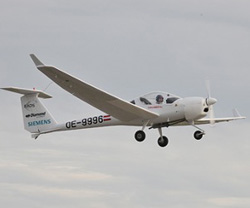World’s First Aircraft With Serial Hybrid Electric Drive

The two-seater motor glider DA36 E-Star is presented by Siemens, Diamond Aircraft and EADS at the Paris Air Show Le Bourget 2011 (until June 26th) in daily flight shows. The aircraft was built to test the hybrid electric drive concept. In the future, the technology, which is intended for later use also in large-scale aircraft, will cut fuel consumption and emissions by 25 percent, compared to today's most efficient aircraft drives.
The motor glider, which is based on Diamond Aircraft's HK36 Super Dimona, is the only aircraft of its kind in the world. It is the first to use a so-called serial hybrid electric drive, which has been utilized to date only in cars, as an integrated drive train. The plane's propeller is powered by a 70 kW electric motor from Siemens. Electricity is supplied by a small Wankel engine from Austro Engine with a generator that functions solely as a power source. A Siemens converter supplies the electric motor with power from the battery and the generator. Fuel consumption is very low since the combustion engine always runs with a constant low output of 30kW. A battery system from EADS provides the increased power required during takeoff and climb. The accumulator is recharged during the cruising phase. The plane is able to start noiseless with the electric drive. It can fly over long distances. During test flights it was airborne for about two hours.
The next development step will be to further optimize the entire drive train. Siemens scientists of the global research department Corporate Technology are currently working on a new electric motor that is expected to be five times lighter than conventional drives. In two years, another aircraft is expected to be equipped with an ultra-light electric drive. Siemens' Drive Technologies Division has already used integrated drive trains in other applications like marine drives. The knowhow gained in these areas has now been applied in the aviation industry as well. Combined with the corresponding product portfolio, the components of the drive train can be optimally adjusted to one another.
Air traffic accounts for some 2.2 percent of CO2 emissions worldwide. For this reason, aircraft, too, must become more efficient. In the long term, however, the drive system will also be used in large-scale aircraft.
Media Contact
More Information:
http://www.siemens.com/innovationnewsAll latest news from the category: Power and Electrical Engineering
This topic covers issues related to energy generation, conversion, transportation and consumption and how the industry is addressing the challenge of energy efficiency in general.
innovations-report provides in-depth and informative reports and articles on subjects ranging from wind energy, fuel cell technology, solar energy, geothermal energy, petroleum, gas, nuclear engineering, alternative energy and energy efficiency to fusion, hydrogen and superconductor technologies.
Newest articles

High-energy-density aqueous battery based on halogen multi-electron transfer
Traditional non-aqueous lithium-ion batteries have a high energy density, but their safety is compromised due to the flammable organic electrolytes they utilize. Aqueous batteries use water as the solvent for…

First-ever combined heart pump and pig kidney transplant
…gives new hope to patient with terminal illness. Surgeons at NYU Langone Health performed the first-ever combined mechanical heart pump and gene-edited pig kidney transplant surgery in a 54-year-old woman…

Biophysics: Testing how well biomarkers work
LMU researchers have developed a method to determine how reliably target proteins can be labeled using super-resolution fluorescence microscopy. Modern microscopy techniques make it possible to examine the inner workings…





















